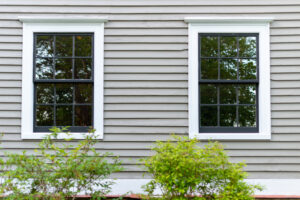The Homeowner’s In-Depth Guide to Double-Pane Windows

*Updated October 9th, 2025
Double-pane windows have a great reputation. Word on the street is they save energy, which saves you money, and may even increase your home’s value. But is it true?
According to the Department of Energy, windows account for 25–30% of energy loss in a home. Choosing the right window type and a professional installer is key to energy efficiency, which means more money in your pocket and a more comfortable home.
Types of Double-Pane Windows
Double-pane windows are a popular choice, but did you know there are several styles to consider? The variety ensures a perfect fit for every home, and understanding these options helps you choose the best windows for your needs.
Framing Material Options
The frames of double-pane window units can be made from various materials, each with its own benefits:
-
Vinyl frames are cost-effective and energy-efficient, requiring minimal maintenance.
-
Wood frames offer timeless appeal but need regular care.
-
Aluminum frames are slim and durable—great for modern homes.
-
Fiberglass frames withstand temperature swings and offer superior insulation.
Gas Fills Between the Panes
Between the two panes of glass, manufacturers often insert inert gases like argon, which is denser than air and adds insulation. This reduces heat transfer and improves comfort inside your home.
Glazing and Glass Type Options
The glazing, or the window glass, can differ depending on your energy goals.
Low-E glass has a thin reflective coating that helps insulate your home, keeping heat out in summer and in during winter. Double-glazed windows and even triple-pane glass options provide better energy efficiency and UV protection.
Design and Grid Varieties
Double-pane windows come in many styles, including casement, sliding, bay, and bow windows. You can also choose a window with grids or specific grid patterns to match your architectural style.
Customization and Energy Ratings
When buying at Home Depot or other major retailers, look for Energy Star® certified and Energy Star qualified models. These window units are tested to meet federal standards and offer energy savings that can cut your energy bills year-round.
Single-Pane vs. Double-Pane vs. Triple-Pane Windows
Comparing single-pane windows, double-pane windows, and triple-pane windows can help you choose the right balance of cost and comfort.
Single-Pane Windows
Single-pane windows have just one layer of glass. Common in older homes, they’re inexpensive but offer poor insulation and low energy efficiency, leading to higher energy bills and less soundproofing.
Double-Pane Windows
Double-pane windows provide excellent insulation thanks to the two sheets of glass set in a sealed window frame, often filled with air or argon gas. This dual-pane construction delivers better energy efficiency and superior insulation compared to single panes.
Triple-Pane Windows
For maximum comfort, triple-pane windows feature three glass panes for the best energy-efficient performance. These replacement windows are ideal for extreme climates, though they come with higher windows cost and weight.
Pros and Cons of Double-Pane Windows
Pros
-
Lower energy bills: Double-pane windows insulate better, meaning less heating and cooling use.
-
More comfort: Maintain steady indoor temperatures inside the home without overusing HVAC systems.
-
Eco-friendly: Reduced energy use cuts your carbon footprint.
-
Better security: A double-paned window is harder to break than a single pane.
-
Less condensation: The additional pane of glass prevents interior fogging and moisture buildup.
Cons
-
Higher upfront cost: A double-pane window costs more than single-pane, though you’ll recoup savings over time.
-
Full-home upgrade: Mixing pane windows can reduce overall energy efficiency.
-
Aesthetic fit: Some older homes may look better with traditional single-pane windows.
The Cost of Double-Pane Windows
Most homeowners pay between $600 and $850 per window unit, depending on materials and glass type. If you shop at Home Depot, you’ll find options like the 50 Series White Single Hung, Series White Double Hung Low-E, or White Double Hung Low-E Argon models. Each glass vinyl replacement window or glass vinyl fin window is designed to offer superior insulation and long-term energy savings.
Professional Installation
Installing a new window isn’t a DIY task. Hiring professionals ensures your double-pane or double-hung windows are properly sealed to maximize energy efficiency. The right expert can install new units that fit snugly in your window frame, helping your windows help you save money on energy.
FAQs About Double-Pane Windows
How do double-pane windows prevent energy loss?
They use two panes of glass separated by a gas-filled gap, creating an insulated glass barrier that slows heat transfer.
Are double-pane windows worth the investment?
Yes. Though they cost more upfront, the energy savings and increased comfort make them worth the investment.
Do double-pane windows reduce outside noise?
Yes. The glazed window construction dampens sound waves, though triple-pane glass performs even better.
Do I need to replace all my windows at once?
For consistent appearance and performance, it’s best to replace all at once, but Home Depot installers can help plan phased upgrades.
Can double-pane windows be customized?
Absolutely. Choose from common window sizes, window use types, and decorative grid patterns to match your style.
Final Thoughts
When choosing between single-pane, double-pane, and triple-pane windows, consider your climate, budget, and comfort needs. Energy Star certified double-pane windows are a smart upgrade that improves curb appeal, lowers energy bills, and keeps your home more comfortable. For most homeowners, they’re not just stylish—they’re worth the investment.
Additional Windows Resources
- How to Replace Glass in a Home Window
- Get Your Home Holiday-Ready with New Windows
- Window Treatments: How to Choose the Right One
- 7 Ways to Add Character to Your Windows
- Professional vs DIY: Making the Right Choice for Window Installation

Anna has over six years of experience in the home services and journalism industries and serves as the Content Manager at MyHomePros.com, specializing in making complex home improvement topics like HVAC, roofing, and plumbing accessible to all. With a bachelor’s degree in journalism from Auburn University, she excels in crafting localized, comprehensive guides that cater to homeowners’ unique needs. Living on both coasts of the United States has equipped her with a distinctive perspective, fueling her passion for turning any house into a cherished home through informed, personalized decision-making.








